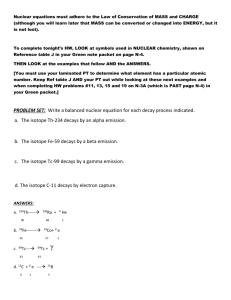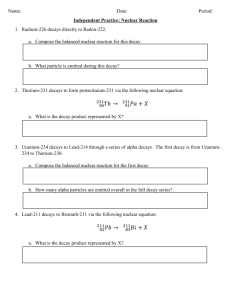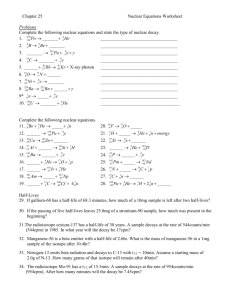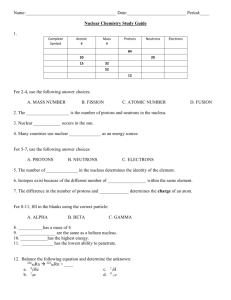nuclear decays
advertisement
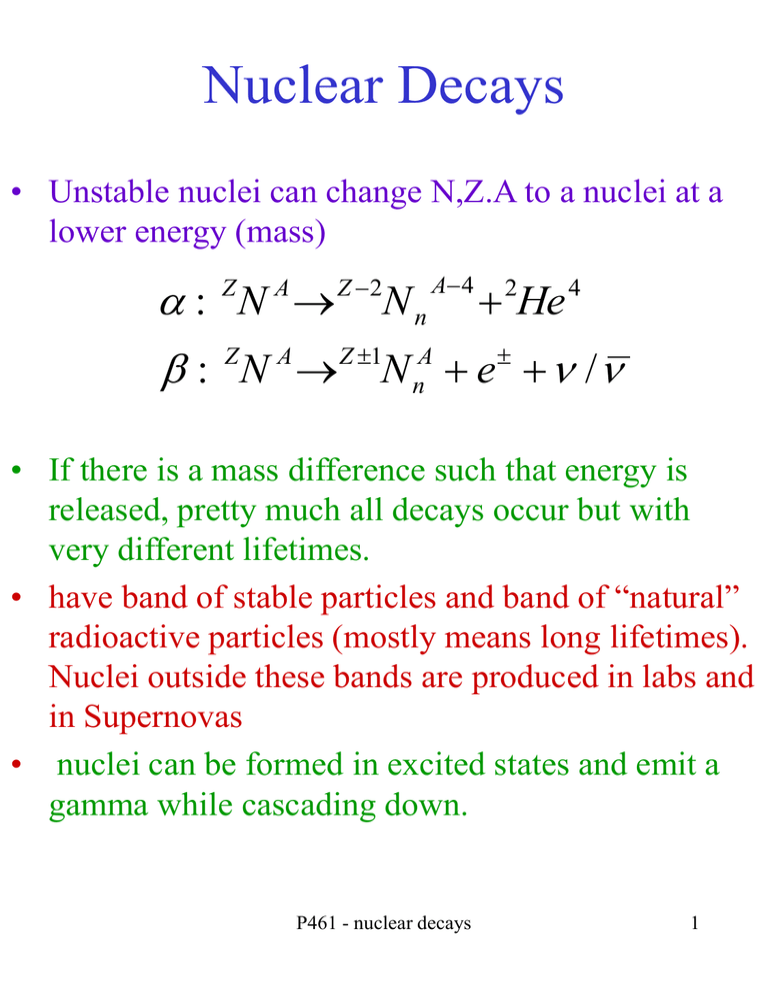
Nuclear Decays • Unstable nuclei can change N,Z.A to a nuclei at a lower energy (mass) : Z N A Z 2N n A4 2He 4 : N N e / Z A Z 1 A n • If there is a mass difference such that energy is released, pretty much all decays occur but with very different lifetimes. • have band of stable particles and band of “natural” radioactive particles (mostly means long lifetimes). Nuclei outside these bands are produced in labs and in Supernovas • nuclei can be formed in excited states and emit a gamma while cascading down. P461 - nuclear decays 1 General Comments on Decays • Use Fermi Golden rule (from perturbation theory) 2 rate | Vif |2 f Vif i*V f dVolume • rate proportional to cross section or 1/lifetime • the matrix element connects initial and final states where V contains the “physics” (EM vs strong vs weak coupling and selection rules) • the density of states factor depends on the amount of energy available. Need to conserve momentum and energy “kinematics”. If large energy available then higher density factor and higher rate. • Nonrelativistic (relativistic has 1/E also. PHYS684) f p dpi dEi each particle 2 i P461 - nuclear decays 2 Simplified Phase Space • Decay: A a + b + c ….. • Q = available kinetic energy Q Mass A mi ( final state) • large Q large phase space higher rate • larger number of final state products possibly means more phase space and higher rate as more variation in momentums. Except if all the mass of A is in the mass of final state particles B D 0 2 body Q 5279 1865 770 2644MeV B D 0 0 3 body Q 5279 1865 770 139 2505MeV • 3 body has little less Q but has 4 times the rate of the 2 body (with essentially identical matrix elements) P461 - nuclear decays 3 Phase Space:Channels • If there are multiple decay channels, each adds to “phase space”. That is one calculates the rate to each and then adds all of them up • single nuclei can have an alpha decay and both beta+ and beta- decay. A particle can have hundreds of possible channels • often one dominates • or an underlying virtual particle dominates and then just dealing with its “decays” c s W W ud , e , , s K mesons • still need to do phase space for each…. P461 - nuclear decays 4 Lifetimes • just one channel with N(t) = total number at time t 1 dN t Rate gamma width N N ( t ) N ( 0) e dt 1 t half life t1 / 2 ln 2 • multiple possible decays. Calculate each (the “partial” widths) and then add up 1 1 2 3 branching fractioni i • Measure lifetime. long-lived (>10-8sec). Have a certain number and count the decays dN / dt 1 N P461 - nuclear decays 5 Lifetimes • Measure lifetime. medium-lived (>10-13sec). Decay point separated from production point. Measure path length. Slope gives lifetime Dx cDt 100 10 1 Dx • short-lived (10-23 < <10-16 sec). Measure invariant mass of decay products. If have all mass of initial. Width of mass distributions (its width) related to lifetime by Heisenberg uncertainty. ( x, t ) ( x )e t / 2 eit ( x ) e t / 2 Dt 2 M DE Dt 1020 sec DE P461 - nuclear decays 100 MeV 1020 6 Alpha decay • Alpha particle is the He nucleus (2p+2n) • ~all nuclei Z > 82 alpha decay. Pb(82,208) is doubly magic with Z=82 and N=126 X X ZX ZX 2 NX NX 2 • the kinematics are simple as non-relativistic and alpha so much lighter than heavy nuclei Q mX mX mHe p X p p2 TX small 2m X A4 KE Q 4 9MeV A • really nuclear masses but can use atomic as number of electrons do not change P461 - nuclear decays 7 Alpha decay-Barrier penetration • One of the first applications of QM was by Gamow who modeled alpha decay by assuming the alpha was moving inside the nucleus and had a probability to tunnel through the Coulomb barrier • from 1D thin barrier (460) for particle with energy E hitting a barrier potential V and thickness gives E E 2 ka Transmission = T T 16 (1 )e V V 2m(V E ) k • now go to a Coulomb barrier V= A/r from the edge of the nucleus to edge of barrier and integrate- each dr is a thin barrier rc T exp( 2 rn 2m 2 Ze 2 ( E ) dr 2 40 r P461 - nuclear decays 2 Ze 2 rc 40 K 8 Alpha decay-Barrier penetration • this integral isn’t easy, need approximations rc T exp( 2 rn 2m 2 Ze 2 ( E ) dr 2 40 r 2 Ze 2 rc 40 K • see nuclear physics textbook (see square) Get T exp( 2zZe2 / v ) exp( 2zZe2 M / 2 K ) • where K = kinetic energy of alpha. Plug in some numbers 2 2 90 (1.4 MeVF ) 4 931MeV T exp( ) 197 MeVF 2 6 MeV T exp( 70) 4 1031 • see www.haverford.edu/physics-astro/songs/alpha.htm P461 - nuclear decays 9 Alpha decay-Barrier penetration • Then have the alpha bouncing around inside the nucleus. It “strikes” the barrier with frequency • • • • • velocity f 2rN the decay rate depends on barrier height and barrier thickness (both reduced for larger energy alpha) and the rate the alpha strikes the barrier larger the Q larger kinetic energy and very strong (exponential) dependence on this as alpha has A=4, one gets 4 different chains (4n, 4n+1, 4n+2, 4n+3). The nuclei in each chain are similar (odd/even, even/even, etc) but can have spin and parity changes at shell boundaries if angular momentum changes, then a suppression of about 0.002 for each change in L (increases potential barrier) 2 l (l 1) 2mr 2 P461 - nuclear decays 10 Alpha decay-Decay chains 4n+2 4n P461 - nuclear decays 11 Alpha decay-Energy levels • may need to have orbital angular momentum if subshell changes (for odd n/p nuclei) • Z= 83-92 1h(9/2) N=127-136 2g(9/2) Z=93-100 2f(7/2) N=137-142 3d(5/2) • so if f(7/2) h(9/2) need L>0 but parity change if L=1 L=2,4 • or d(5/2) g(9/2) need L>1. No parity change L=2,4 • not for even-even nuclei (I=0). suppression of about 0.002 for each change in L (increases potential barrier) s 0 p 1 d 2 f 3 g 4 h 5 P461 - nuclear decays 12 Parity + Angular Momentum Conservation in Alpha decay • X Y + . The spin of the alpha = 0 but it can have non-zero angular momentum. Look at Parity P PX PY P Porbit P 1, Porbit ( 1)l • if parity X=Y then L=0,2…. If not equal L=1,3… U 235 Th 231 # n 143 1i11/ 2 112 # n 141 3d 5 / 2 5 2 (i, l 6) (d , l 2) Lorbital ( 112 52 ) 3 Lorbital 4,6 • to conserve both Parity and angular momentum P461 - nuclear decays 13 Energy vs A Alpha decay P461 - nuclear decays 14 Lifetime vs Energy in Alpha Decays Perlman, Ghiorso, Seaborg, Physics Review 75, 1096 (1949) 10 log10 half-life in years 0 -10 5 7 Alpha Energy MeV P461 - nuclear decays 15 Beta Decays • Beta decays are proton neutrons or neutron proton transitions • involve W exchange and are weak interaction M Z , A M Z 1, A e e ( p ne ) M Z , A M Z 1, A e e (n pe ) e M Z , A M Z 1, A e (ep n ) • the last reaction is electron capture where one of the atomic electrons overlaps the nuclei. Same matrix element (essentially) bit different kinematics • the semi-empirical mass formula gives a minimum for any A. If mass difference between neighbors is large enough, decay will occur P461 - nuclear decays 16 Beta Decays - Q Values • Determine Q of reactions by looking at mass difference (careful about electron mass) : X Z , A YZ 1, A e e m X ( Zme ) mY ( Zme ) KY me K e K Q AtomicMass X AM Y KY K e K : X Z , A YZ 1, A e e m X ( Zme ) mY ( Zme ) KY me K e K Q AM X AM Y 2me EC : e X Z , A YZ 1, A e me m X ( Zme ) mY ( Zme ) K Y K e K Q AM X AM Y • 1 MeV more Q in EC than beta+ emission. More phase space BUT need electron wavefunction overlap with nucleus..... P461 - nuclear decays 17 Beta+ vs Electron Capture • Fewer beta+ emitters than beta- in “natural” nuclei (but many in “artificial” important in Positron Emission Tomography - PET) • sometimes both beta+ and EC for same nuclei. Different widths • sometimes only EC allowed 3 Li 7 M 7.01600u Be 7 M 7.01693u DM .00093u < 2 me 2 .00055u 4 4 Be 7 e 3Li 7 • monoenergetic neutrino. E=.87 MeV. Important reaction in the Sun. Note EC rate different in Sun as it is a plasma and not atoms P461 - nuclear decays 18 Beta+ vs Electron Capture • from Particle Data Group p p2H e 8 7 B8Be e Be e7Li P461 - nuclear decays 19 Beta Decay - 3 Body • The neutrino is needed to conserve angular momentum • (Z,A) (Z+1,A) for A=even have either Z,N even-even odd-odd or odd-oddeven-even • p,n both spin 1/2 and so for even-even or odd-odd nuclei I=0,1,2,3……. • But electron has spin 1/2 I(integer) I(integer) + 1/2(electron) doesn’t conserve J • need spin 1/2 neutrino. Also observed that electron spectrum is continuous indicative of >2 body decay • Pauli/Fermi understood this in 1930s electron neutrino discovered 1953 (Reines and Cowan) muon neutrino discovered 1962 (Schwartz +Lederman/Steinberger) tau neutrino discovered 2000 at Fermilab P461 - nuclear decays 20 3 Body Kinematics • While 3 body the nuclei are very heavy and easy approximation is that electron and neutrino split available Q (nuclei has similar momentum) • maximum electron energy when E(nu)=0 X Y e p y pe let E 0 conserve momentum (mx Ee m ) 2 E y2 Ee max mx2 m y2 me2 2m x K e Ee me • example conserve energy ( m ) (mx m y me )( mx m y me ) 2mx Q Mg 12 27Al13 e m27,12 26.9843, m27,13 26.981 27 me .00055 Q 2.8MeV pe Ee2 me2 2.75MeV , e E 5 .5 m p2 K Al 0.2keV small 2m P461 - nuclear decays 21 Beta decay rate • Start from Fermi Golden Rule 2 2 Rates | M | Final M F* d • first approximation (Fermi). Beta=constant=strength of weak force M M M Z* 1 Z d • Rule 1: parity of nucleus can’t change (integral of odd*even=0) • Rule 2: as antineutrino and electron are spin 1/2 they add to either 0 or 1. Gives either Fermi : Di iZA iZ 1 A 0 42 Sc 21 42Ca 20 e 0 0 Gamow Teller : Di 1 (not 0 1 0) 32 P15 22S 16 e 1 0 P461 - nuclear decays 22 Beta decay rate II • Orbital angular momentum suppression of 0.001 for each value of L (in matrix element calculation) 36 Sc17 36Ca18 e 2 0 Di 1 L 1 • look at density of states factor. Want # quantum states per energy interval dN n 2 2 Rates | M | Final n dEn • we know from quantum statistics that each particle (actually each spin state) has p2 dN 4 3 dp h • 3 body decay but recoil nucleus is so heavy it doesn’t contribute 2 2 pe p dN 4 3 dpe 4 3 dp h h p (Q K e ) / c P461 - nuclear decays 23 Beta decay rate III • Conservation of energy allows one to integrate over the neutrino (there is a delta function) Rates dN 2 | M |2 Final dpe 2 2 2 2 4pe 4 (Q K e ) |M | h3 (hc)3 K e ( pe2 me2 )1/ 2 me • this gives a distribution in electron momentum/energy which one then integrates over. (end point depends on neutrino mass) 1 me5c 4 2 Rate | M | F ( Ee max ) 3 7 T 2 • F is a function which depends on Q. It is almost loqrithmic log F A log K e max P461 - nuclear decays 24 actual. not “linear” due to electron mass log F A log K e max 4.4 log K .5 F 3K 4.4 P461 - nuclear decays 25 Beta decay rate IV • FT is “just kinematics” • measuring FT can study nuclear wavefunctions M’ and strength of the weak force at low energies • lower values of FT are when M’ approaches 1 • beta decays also occur for particles 0 e e K 0 e e • electron is now relativistic and E=pc. The integral is now easier to do. For massive particles (with decay masses small), Emax = M/2 and so rate goes as fifth power of mass p max 2 2 5 ( Q K ) p dp E e e e max / 30 0 P461 - nuclear decays 26 Beta decay rate V • M=M’ is strength of weak interaction. Can measure from lifetimes of different decays 1062 joule m3 100 eV F 3 • characteristic energy 100eV * F 3 0.1eV 3 vol (10F ) • strong energy levels ~ 1 MeV weak 107 relative strength 1014 strong • for similar Q, lifetimes are about strong 10 s 23 EM 1016 s weak 1010 s P461 - nuclear decays 27 Parity Violation in Beta Decays • The Parity operator is the mirror image and is NOT conserved in Weak decays (is conserved in EM and strong) P ( x, y, z ) ( x, y, z ) P ( r , , ) ( r , , ) • non-conservation is on the lepton side, not the nuclear wave function side • spin 1/2 electrons and neutrinos are (nominally) either right-handed (spin and momentum in same direction) or left-handed (opposite) • Parity changes LH to RH • RH P( p) p P( L r p) L LH P461 - nuclear decays 28 “Handedness” of Neutrinos • “handedness” is call chirality. If the mass of a neutrino = 0 then: • all neutrinos are left-handed all antineutrinos are right-handed • Parity is maximally violated • As the mass of an electron is > 0 can have both LH and RH. But RH is suppressed for large energy (as electron speed approaches c) • fraction RH vs LH can be determined by solving the Dirac equation which naturally incorporates spin P461 - nuclear decays 29 Polarized Beta Decays • Some nuclei have non-zero spin and can be polarized by placing in a magnetic field • magnetic moments of nuclei are small (1/M factor) and so need low temperature to have a high polarization (see Eq 14-4 and 14-5) Co60Ni e 60 i5 i 4 s 12 , 12 • Gamow-Teller transition with S(e-nu) = 1 • if Co polarized, look at angular distribution of electrons. Find preferential hemisphere (down) Pnu pe Spin antinu-RH Spin e - LH Co P461 - nuclear decays 30 Discovery of Parity Violation in Beta Decay by C.S. Wu et al. • Test parity conservation by observing a dependence of a decay rate (or cross section) on a term that changes sign under the parity operation. If decay rate or cross section changes under parity operation, then the parity is not conserved. • Parity reverses momenta and positions but not angular momenta (or spins). Spin is an axial vector and does not change sign under parity operation. 180o Pe neutron Beta decay of a neutron in a real and mirror worlds: If parity is conserved, then the probability of electron emission at is equal to that at 180o-. Selected orientation of neutron spins - polarisation. Pe P461 - nuclear decays 31 Wu’s experiment • Beta-decay of 60Co to 60Ni*. The excited 60Ni* decays to the ground state through two successive emissions. • Nuclei polarised through spin alignment in a large magnetic field at 0.01oK. At low temperature thermal motion does not destroy the alignment. Polarisation was transferred from 60Co to 60Ni nuclei. Degree of polarisation was measured through the anisotropy of gamma-rays. • Beta particles from 60Co decay were detected by a thin anthracene crystal (scintillator) placed above the 60Co source. Scintillations were transmitted to the photomultiplier tube (PMT) on top of the cryostat. P461 - nuclear decays 32 Wu’s results • Graphs: top and middle - gamma anisotropy (difference in counting rate between two NaI crystals) control of polarisation; bottom - asymmetry - counting rate in the anthracene crystal relative to the rate without polarisation (after the set up was warmed up) for two orientations of magnetic field. • Similar behaviour of gamma anisotropy and beta asymmetry. • Rate was different for the two magnetic field orientations. • Asymmetry disappeared when the crystal was warmed up (the magnetic field was still present): connection of beta asymmetry with spin orientation (not with magnetic field). • Beta asymmetry - Parity not conserved P461 - nuclear decays 33 Gamma Decays • If something (beta/alpha decay or a reaction) places a nucleus in an excited state, it drops to the lowest energy through gamma emission • excited states and decays similar to atoms • conserve angular momentum and parity • photon has spin =1 and parity = -1 • for orbital P= (-1)L • first order is electric dipole moment (edm). Easier to have higher order terms in nuclei than atoms N* N 3 2 L 0, edm 2 0 L 1, e.quad .mom. Pfinal P PN (1) L (1)( 1)( 1) P461 - nuclear decays 34 Gamma Decays 2 5 17 Cl 38 18 Ar38 26% E MeV gamma 11% 3 2 53% gamma 0 0 N N * 2 3 GT 3 2 L 0; edm 2 0 L 1; eqm 2 2 GT L 1 ( P change) L 1 2 0 Di 2; GT L 1 P conserve angular momentum and parity. lowest order is electric dipole moment. then quadrapole and magnetic dipole P461 - nuclear decays 35 Mossbauer Effect • Gamma decays typically have lifetimes of around 10-10 sec (large range). Gives width: 1015 eVs DE 10 105 eV 10 sec • very precise • if free nuclei decays, need to conserve momentum. Shifts gamma energy to slightly lower value A* A p A p E M A2* M A2 2M A* DM DM (1 ) 2M • example. Very small shift but greater than natural width DM .13MeV , M 191* 931.5 E .13MeV .005eV P461 - nuclear decays 36 Mossbauer Effect II • Energy shift means an emitted gamma won’t be reabsorbed A* A E .13 .000000005MeV A A* E .13 .000000005MeV • but if nucleus is in a crystal lattic, then entire lattice recoils against photon. Mass(lattice)infinity and Egamma=deltaM. Recoiless emission (or Mossbauer) • will have “wings” on photon energy due to lattice vibrations • Mossbauer effect can be used to study lattice energies. Very precise. Use as emitter or absorber. Vary energy by moving source/target (Doppler shift) (use Iron. developed by R. Preston, NIU) P461 - nuclear decays 37 Nuclear Reactions, Fission and Fusion • • • • 2 Body reaction A+BC+D elastic if C/D=A/B inelastic if mass(C+D)>mass(A+B) threshold energy for inelastic (B at rest) 2 2 M 2 Etot ptot (mC mD ) 2 mA mB mC mD K th Q 2 mB K th Q Q DM m A mB (non relativistic ) mB • for nuclei nonrelativistic usually OK p 3H 2H 2H Q (1.007825 3.016049 2 2.014102)u 4.03MeV K th 4(1 13 ) 5.38MeV (non rel ) K th 5.47 MeV (rel ) P461 - nuclear decays 38 Nuclear Reactions (SKIP) • A+BC+D • measurement of kinematic quantities allows masses of final states to be determined • (p,E) initial A,B known • 8 unknowns in final state (E,px,py,pz for C+D) • but E,p conserved. 4 constraints4 unknowns measure E,p (or mass) of D OR C gives rest or measure pc and pd gives masses of both • often easiest to look at angular distribution in C.M. but can always convert d d CM P461 - nuclear decays 39 Fission • AB+C A heavy, B/C medium nuclei • releases energy as binding energy/nucleon = 8.5 MeV for Fe and 7.3 MeV for Uranium • spontaneous fission is like alpha decay but with different mass, radii and Coulomb (Z/2)2 vs 2(Z-2). Very low rate for U, higher for larger A • induced fission n+AB+C. The neutron adds its binding energy (~7 MeV) and can put nuclei in excited state leading to fission • even-even U(92,238). Adding n goes to even-odd and less binding energy (about 1 MeV) • even-odd U(92,235), U(92,233), Pu(94,239) adding n goes to even-even and so more binding energy (about 1 MeV) 2 MeV difference between U235 and U238 • fission in U235 can occur even if slow neutron P461 - nuclear decays 40 Spontaneous Fission • P461 - nuclear decays 41 Induced Fission • P461 - nuclear decays 42 Neutron absorption • P461 - nuclear decays 43 Fusion m(1H ) 1.007825u m( H ) 2.014102u m( 4He ) < 4 m(1H ) m( He ) 4.002603u m(12C ) < 3 m( 4He ) 2 4 m(8Be ) 8.005305u m(12C ) 12.00000u • • • • • “nature” would like to convert lighter elements into heavier. But: no free neutrons need to overcome electromagnetic repulsion high temperatures mass Be > twice mass He. Suppresses fusion into Carbon Ideally use Deuterium and Tritium, =1 barn, but little Tritium in Sun (ideal for fusion reactor) 2 H 3H 4He n Q 17 MeV P461 - nuclear decays 44 Fusion in Sun m(1H ) 1.007825u m( H ) 2.014102u 2 m( He ) 4.002603u 4 m( Be ) 8.005305u 8 p p 2H e p 2H 3He 3 He 3He 4He p p m(12C ) 12.00000u • • • • rate limited by first reaction which has to convert a p to a n and so is Weak (pp) ~ 10-15 barn partially determines lifetime of stars can model interaction rate using tunneling – very similar to Alpha decay (also done by Gamow) tunneling probability increases with Energy (Temperature) but particle probability decreases with E (Boltzman). Have most probable (Gamow Energy). About 15,000,000 K for Sun but Gamow energy higher (50,000,000??) P461 - nuclear decays 45 Fusion in Sun II m(1H ) 1.007825u 4 He 4He 8Be m( 2H ) 2.014102u 8 Be 4He 12C m( 4He ) 4.002603u m(8Be ) 8.005305u m(12C ) 12.00000u mBe 2mHe 92 KeV Be 1012 sec • need He nuclei to have energy in order to make Be. (there is a resonance in the if have invariant mass(He-He)=mass(Be)) • if the fusion window peak (the Gamow energy weighted for different Z,mass) is near that resonance that will enhance the Be production • turns out they aren’t quite. But fusion to C start at about T=100,000,000 K with <kT> about 10 KeV each He. Gamow energy is higher then this. P461 - nuclear decays 46 Fusion in Sun III m(1H ) 1.007825u 4 He 4He 8Be m( 2H ) 2.014102u 8 Be 4He 12C m( 4He ) 4.002603u m(8Be ) 8.005305u m(12C ) 12.00000u • mBe 2mHe 92 KeV Be 1012 sec Be+HeC also enhanced if there is a resonance. Turns out there is one at almost exactly the right energy --- 7.65 MeV Dm 0.28MeV C * 0 11,185.65 MeV 11,185.37 mBe mHe 12 7.65 MeV 11,185.27 3mHe 2 4.44 MeV 0 11,178 MeV P461 - nuclear decays 47
